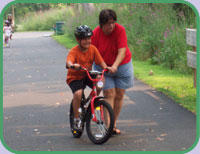 Gross motor skills are important whether you are riding a bicycle, playing soccer or climbing a rock wall. The coordination of our body’s major muscle groups requires an intricate neurological dance involving sensory discrimination, motor planning, balance, strength and endurance. A misstep in this interplay can inhibit successful participation in recess play and sports and may have social and emotional ramifications. Therapy can help children move in the right direction.
Gross motor skills are important whether you are riding a bicycle, playing soccer or climbing a rock wall. The coordination of our body’s major muscle groups requires an intricate neurological dance involving sensory discrimination, motor planning, balance, strength and endurance. A misstep in this interplay can inhibit successful participation in recess play and sports and may have social and emotional ramifications. Therapy can help children move in the right direction.
Skilled movement requires our brains to coordinate sensory input from the five senses (sight, sound, taste, touch, and smell) with two "hidden" body senses. These are the proprioceptive and vestibular senses, which work on an unconscious level.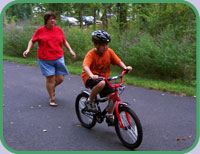
Those of us who have experienced vertigo or middle ear infections have felt the importance of vestibular functioning. Under these conditions, standing up, walking across the room, or moving our heads from side to side can be so disorienting that we are unable to perform our typical activities of daily living. Located in the inner ear and stimulated by head, neck, eye and body movements, the vestibular system is the foundation for the development of balance. It responds to the pull of gravity and provides information about the position and movement of the head. Therefore, it lets us know if we are at rest or moving, and the speed and direction of our movement. It also provides information about the movement of objects around us. This information is crucial to coordinating head and eye movements and using the two sides of our body at the same time. When we lose our balance and begin to fall, our body's vestibular system activates muscles to pull us back into balance. The vestibular system also modulates muscle tone. For signs and symptoms of vestibular dysfunction, click here.
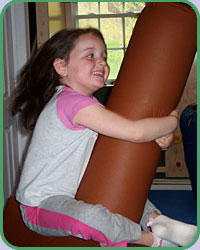 Proprioception contributes to the understanding of our own body -- its position and how it's moving -- through sensors in our muscles, joints and tendons. Just as we don't think about activating our heart muscle to beat, we don't typically think about all the specific positioning and repositioning of our body parts required to stand in a line, hit a ball or walk across a crowded room. Proprioceptive input also tells us how much force is needed for tasks. For instance, we know how much pressure we need in order to hold and write with a pencil and the amount of force we need to pick up a backpack or throw a ball thanks to proprioception.
Proprioception contributes to the understanding of our own body -- its position and how it's moving -- through sensors in our muscles, joints and tendons. Just as we don't think about activating our heart muscle to beat, we don't typically think about all the specific positioning and repositioning of our body parts required to stand in a line, hit a ball or walk across a crowded room. Proprioceptive input also tells us how much force is needed for tasks. For instance, we know how much pressure we need in order to hold and write with a pencil and the amount of force we need to pick up a backpack or throw a ball thanks to proprioception.
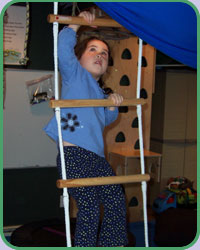 After we have received information from our seven sensory systems, our brains have to synthesize it all for skilled movement. There are three components of sensory processing -- sensory modulation, sensory discrimination and motor planning. Sensory modulation allows us to respond to relevant sensory input and disregard other sensations. Our sensory likes and dislikes, as well as the quantity of sensory stimulation that we prefer, are determined by the modulation component. Our tolerance of sensation is very personal and situational. One person may enjoy music while reading while another requires silence, but both may enjoy music while doing household chores. Also, our ability to modulate sensation changes as sensation accumulates, the so-called "summation effect." Children with difficulties modulating sensory input may fear typical sensations or seek extreme sensation. Read some examples.
After we have received information from our seven sensory systems, our brains have to synthesize it all for skilled movement. There are three components of sensory processing -- sensory modulation, sensory discrimination and motor planning. Sensory modulation allows us to respond to relevant sensory input and disregard other sensations. Our sensory likes and dislikes, as well as the quantity of sensory stimulation that we prefer, are determined by the modulation component. Our tolerance of sensation is very personal and situational. One person may enjoy music while reading while another requires silence, but both may enjoy music while doing household chores. Also, our ability to modulate sensation changes as sensation accumulates, the so-called "summation effect." Children with difficulties modulating sensory input may fear typical sensations or seek extreme sensation. Read some examples.
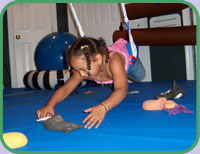 Efficient sensory discrimination informs our brains about the specific qualities of sensation so it can distinguish one experience from another. Sensory discrimination allows us to determine if a siren is moving toward or away from us. We are able to learn about the size, shape and texture of objects and discern body positions and movements. Difficulties with sensory discrimination frequently result in poor coordination and delayed development of motor skill. Click here for more functional signs of inefficient perception of sensation.
Efficient sensory discrimination informs our brains about the specific qualities of sensation so it can distinguish one experience from another. Sensory discrimination allows us to determine if a siren is moving toward or away from us. We are able to learn about the size, shape and texture of objects and discern body positions and movements. Difficulties with sensory discrimination frequently result in poor coordination and delayed development of motor skill. Click here for more functional signs of inefficient perception of sensation.
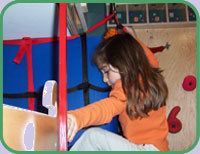 Motor planning or praxis (from the Greek, “to do”) is the ability to formulate an idea, to make a plan that includes timing and sequencing, and to execute the plan for a new or non-habitual movement. The processes of beginning and ending movement are discrete aspects of motor planning, as are the minute adjustments in response to body feedback and environmental cues that must take place once movement is initiated. Dyspraxia is the term applied when children have difficulty with motor planning. For signs of dyspraxia, please click here.
Motor planning or praxis (from the Greek, “to do”) is the ability to formulate an idea, to make a plan that includes timing and sequencing, and to execute the plan for a new or non-habitual movement. The processes of beginning and ending movement are discrete aspects of motor planning, as are the minute adjustments in response to body feedback and environmental cues that must take place once movement is initiated. Dyspraxia is the term applied when children have difficulty with motor planning. For signs of dyspraxia, please click here.
 When children feel clumsy and are not adept at activities that other children easily perform, they may lose self-esteem. In addition, these children may come to feel that trying is just too hard, and some may refuse to participate in physical activities. The refusal may be subtle, with the child insisting that they do not like these activities, or the child may over-engage in passive nonphysical activities to avoid potential for embarrassment (for example, excessive computer gaming to avoid a neighborhood game of baseball). Unfortunately, the lack of participation in recreational group play may lead to decreased opportunities for developing social skills. On the playground, we learn to make friends, collaborate, compete graciously and negotiate conflict.
When children feel clumsy and are not adept at activities that other children easily perform, they may lose self-esteem. In addition, these children may come to feel that trying is just too hard, and some may refuse to participate in physical activities. The refusal may be subtle, with the child insisting that they do not like these activities, or the child may over-engage in passive nonphysical activities to avoid potential for embarrassment (for example, excessive computer gaming to avoid a neighborhood game of baseball). Unfortunately, the lack of participation in recreational group play may lead to decreased opportunities for developing social skills. On the playground, we learn to make friends, collaborate, compete graciously and negotiate conflict.
An OT evaluation, which includes your valuable input, will assist in determining the extent to which dysfunctional sensory processing has contributed to your child's challenges.
 Therapeutic intervention at Giant Leaps strengthens the foundational components of gross motor skill development. Other frames of reference or modalities may be used solely or in conjunction with sensory integration therapy as needed for each individual child. We commonly apply neurodevelopment technique (NDT), motor learning and cognitive strategies. Interactive Metronome, an inventive strategy requiring the participant to make targeted movements to an auditory stimulus, is used to help develop motor planning and bilateral coordination. Additionally, the interactive metronome program has had great success improving focus in children with attention deficits.
Therapeutic intervention at Giant Leaps strengthens the foundational components of gross motor skill development. Other frames of reference or modalities may be used solely or in conjunction with sensory integration therapy as needed for each individual child. We commonly apply neurodevelopment technique (NDT), motor learning and cognitive strategies. Interactive Metronome, an inventive strategy requiring the participant to make targeted movements to an auditory stimulus, is used to help develop motor planning and bilateral coordination. Additionally, the interactive metronome program has had great success improving focus in children with attention deficits.






